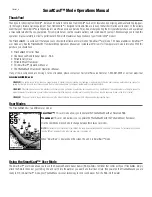
The returned “echoes” are transmitted with wireless technology to the display unit and plotted on the LCD. New information appears on the right. As this
information moves to the left a very accurate picture of the underwater world is created, including the depth of underwater objects such as the bottom, fish,
and structures.
WARNING!
The electronic parts in the Remote Sonar Sensor (RSS) are made to withstand use when casting into water. Because shock from abrupt contact with rocks can damage your
RSS, we recommend using your RSS in water deeper than 1 foot only.
While in SmartCast™ mode, the Advanced RSS can be used in two distinct ways:
Sonar Graph:
The RSS can be used to create a sonar graph of the bottom. Cast the RSS into the
water beyond an area of interest. Retrieving the RSS slowly and steadily will produce a screen
detailing structure, fish and bottom detail. Rhythmic wave action and rocking may cause the display
of a rippled bottom.
Stationary Float:
The RSS can be used as a float in a stationary location to monitor the area below, giv-
ing you a live update as fish approach your bait.
Attaching the RSS
The line coming from your reel can be tied off to the front hole in the RSS. If you wish to also use the RSS as a conventional float, use the second hole to
attach your hook using a lighter weight line. A snag will break the lighter line if you have to break free. Slip line techniques are not recommended because
of the higher risk of losing the RSS. If you do use the slip line method, use a lighter weight line after the lower stop, enabling retrieval of the RSS if the
lower line with hook breaks away.
Water Surface Line
Depth – Measured at
the Transducer
Structure
Surface Clutter
Upper Range
Temperature
Fish ID+ Symbols
Bottom Contour
Lower Range
To scan an area, cast and then reel in at a steady
rate with your rod tip up. Jerks may break water
contact, causing gapped signal input. A low rod
tip or heavy line may cause signal loss if the
RSS submerges.












